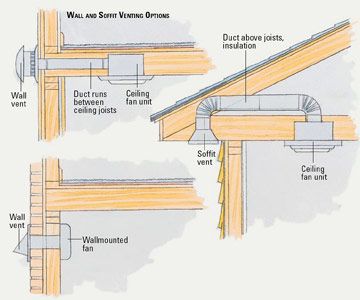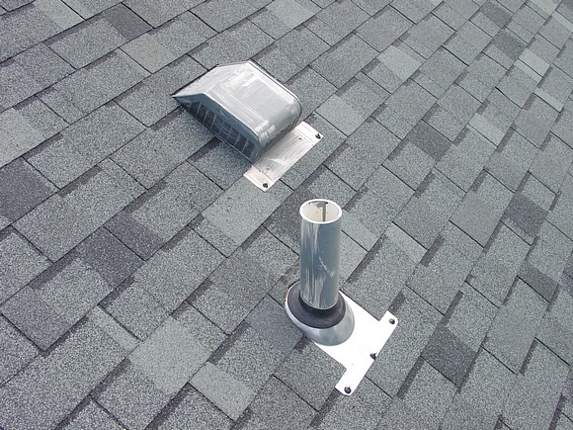Bathroom Vent System
The bathroom exhaust fan, as deafening as some may sound, is an integral part of your home’s ventilation system.
High humidity levels from a warm bath or shower has the potential of creating mold and mildew. Painted walls will crack, wall paper will peel, and doors and cabinets will start to warp in a consistently damp bathroom. A bathroom’s ventilation system extracts moist air and odor and expel it to the outside of the home. If your exhaust fan is functioning properly, the bathroom should not be foggy nor should water vapor appear on the mirrors.
Function and Purpose
Basically, bathroom exhaust fans run on an electrically powered motor. The motor powers the fan, which abstracts moist air into ductwork to the outside of the home through a soffit vent or sidewall vent.
Bathroom sizes vary, therefore, fan choices will vary. Vent fans are rated by the amount of cubic feet of air they can move in one minute (CFM). The higher the CFM, the more air the fan can move. So, the bigger your bathroom, the higher the CFM you’ll need. For example, the minimum ventilation required is 50 CFM. This number covers a bathroom size up to 50 square feet. If your bathroom is more than 50 square feet, multiply the room’s square footage by 1 CFM to determine the exhaust fan size needed.
Fan Options
Unlike the first Ford Model-T (you could purchase any color as long as it’s black!), there are at least four bathroom exhaust fans options: ceiling-mounted, inline, wall-mounted, and combination units.
Ceiling-mounted – The most common and popular version, this fan works by pulling the air up through the vent. The motor then pushes the air through the ducts and exits outside of the home via vents. Visually pleasing, additional features includes light unit, heating element, or attractive finishes.
Inline – This fan works the same as the ceiling-mount exhaust fan. The difference is the installation, where it is attached to a joist in the attic above the bathroom. The fan’s ceiling cover is a louvered  vent.
vent.
Wall-mount – The wall-mount is used primarily for cathedral ceilings, where there is no attic space above the ceiling. No ductwork is required if it is mounted to an exterior wall. If mounted to an interior wall, ductwork is required.
Combination-unit – This is an all-in-one bathroom exhaust fan and you can expect to pay a little more for the features. Not only are these fans attractive, but the features such as lighting, heating element, humidity sensor, and extra quiet motors could turn your bathroom into a desired hangout spot.
Ductwork – Important!!
The bathroom exhaust fan will not serve its purpose without adequate ducting. Important points about the ductwork:
Installation – Mount according to manufacturer’s instructions.
Length – Short, straight, and no twists or turns.
Termination – Duct must terminate outside of the home (not within the attic or walls) and should have a screen to prevent rodents and insects from entering. If terminating to the roof, duct should be outfitted with a cap.
Connection - Make sure the bathroom exhaust fan is properly connected to the ductwork and the ductwork is ventilated to the exterior of your home. The ductwork will exhaust the humid air to the outdoors. Exhausting the fan directly to the attic space moves the humidity from the bathroom to the attic. The results will potentially cause decay from mold, damage drywall, and decrease the effectiveness of the attic insulation.
This picture is an example of an exhaust fan disconnected from the duct in the attic.
Bathroom exhaust fans may appear to be an insignificant appliance. Without it you will not clearly see yourself in the mirror, you’ll find yourself repainting the bathroom walls, and above all else, your family’s health could be at risk. An adequately sized bathroom ventilation fan with a light (why not?), properly installed and ducted to the outside of your home will prevent mold development, structural rotting and respiratory health concerns for you and your family.
Avid Inspection Services, LLC © . Privacy Policy

